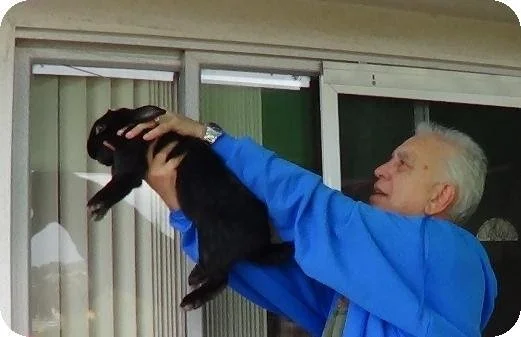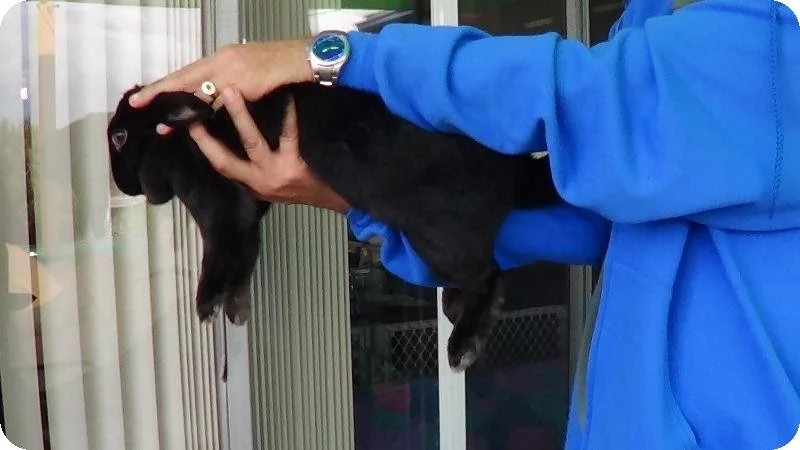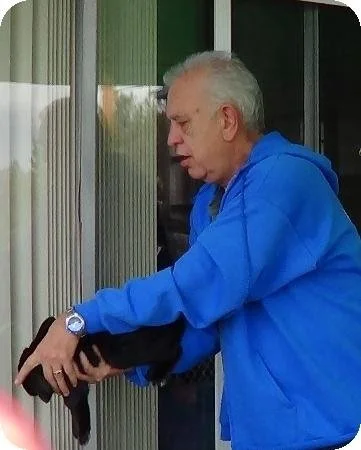Choking
WATCH THIS VIDEO IF YOUR RABBIT IS CHOKING.
IT WILL SHOW YOU WHAT TO DO IN A CHOKING EMERGENCY
Choking is often deadly. You must act fast. Here are some methods to clear a rabbit's blocked airway -
Read through the information below as well as that in the links in addition to watching the video BEFORE you need it so that you are prepared.
The following information is provided for reference only. Ask your rabbit savvy vet about this subject before you need to use it! They can show you the correct technique for your rabbit! There can be very serious negative consequences using the techniques below if they are used incorrectly!
Very Dangerous:
Rabbits can not vomit and therefore choking is a very extreme issue with them. Stephan Flores (The Bunny Guy) wanted to express how very serious using the "Heimlich manoeuvre" is! It is possible to break a rabbits neck or become severely injured. Anything from fractured vertebrae to even death. Ask your rabbit savvy vet about this subject before you need to use it!!! Most choking information for rabbits (on the web) is based on "The Bunny Guy" or Dana Krempels's posted information.
Choking = Vet ASAP:
Even after a choking event the rabbit should see a rabbit savvy vet as soon as possible. If the rabbit dislodges the food/blockage itself (or with help) most likely the rabbit has aspirated. Many vets will put the rabbit on antibiotics to prevent...
Pneumonia
Sinus issues
Prevent respiratory tract infections
Some vets will also give a few days of a non-steroidal anti-Inflammatory such as Metacam (Meloxicam).
Other Choking Issues:
There are also other issues that can cause a rabbit to choke that a rabbit savvy vet can help and identify.
Mega Oesophagus - Mega oesophagus is very rare in rabbits but does happen. If your rabbit has a lot of choking/regurgitation events you should ask your rabbit savvy vet amount this!
Elongated soft palate, which may interfere with the ability to regulate swallowing and breathing.
Dental issues. "Hay, etc can get caught on molar spurs" - by Sandi Ackerman; House Rabbit Journal Winter 2009: Volume V, Number 4 HRS
Things to look for if a rabbit is choking
Rabbit lifting its head and pointing its nose to the air - this is them trying to breathe, it is also seen in rabbits with heart issues.Making gurgling or whistling sounds.
Laboured breathing, panting and gasping type breaths (like you'd see in a human choking)
Turning blue - their gums that is, not fur! This is lack of oxygen, and again something you might see in a human.
Rabbit pawing at its mouth and moving around whilst chewing.
Methods & Techniques
"Centrifugal Swing" - the safest option...
Many refer to this technique as the "Bunny Heimlich," when in fact swinging the rabbit tries to take advantage of centrifugal force. This force will hopefully push the bunny's internal organs forward and in turn force air out of the lungs, and with luck, it will clear the rabbit's trachea.
Method 1 - As preformed by Stephan Flores (The Bunny Guy). Support here comes mainly from the top and bottom, but also supplies good support to the sides.
Place the rabbit on your forearm (right arm for right-handed people; left arm for left-handed folks) with his legs straddling it. Grip his head on both sides with that hand, and use your other hand to hold him tightly against your arm.
Make sure to position your hands correctly
The thumb and forefinger are in front of his front legs supporting his head underneath his chin. The other hand is supporting his head and whole spinal column so that the violent manoeuvre does not injure his back or neck. The back legs are on either side of the fore arm.
Lift him so he is just above the level of your head...
... then swing the rabbit down quickly - supporting the head and neck at all times. Obviously, if you don’t have a tight hold on him, you can throw him onto the floor, so be very sure that you have a tight grasp. It might help to wrap a dish towel around him and your arm, so that the towel helps hold him on your arm.
It may take several repetitions of this effort to dislodge whatever is choking him. Once he begins breathing, he may cough and sputter, clearing out whatever has been left behind, but his lips should begin to grow pink again. Don’t continue the if he’s doing this.
Source:
Things to look for if a rabbit is choking - There's heaps of info on this website. It's worth reading through all of it.
Bunny Heimlich Maneuver - by Nancy LaRoche, Colorado House Rabbit Society
Other Methods & Techniques
"Thoracic Compressions"
"Choking episodes fortunately are rare, but if they occurred, I'd probably recommend thoracic compressions (slap both sides of the chest simultaneously, causing exhalation of air rapidly, like a cough). Bunny thorax expands side to side, not front to back, so side compressions are best, and relatively safe. Hope this helps." - Mark Burgess DVM, Southwest Animal Hospital
An Article by Megan Schommer DMV
Choking in rabbits:Choking is one of the scariest things that a pet owner can witness. If you know what choking looks like, you might have a chance to intervene in time to help your bunny before it’s too late. If you are a veterinarian, it’s also important to know what follow-up care might be needed if you get a call from an owner that their rabbit has just choked.
First, we should get our definition of choking straight. There are two different things that are commonly referred to as “choking”.
The type of choking that we think of first is obstruction of the airway by something (usually food). The second type of choking is esophageal obstruction, in which a bolus of something (again, usually food) gets stuck in the esophagus. Both of these can be very distressing to rabbits, but a tracheal obstruction is a true emergency that needs immediate intervention if your rabbit is going to survive.
Here is how these episodes differ:
True choking (tracheal obstruction) means that no air can move in or out of the lungs. A rabbit who is choking will look distressed initially. They may have their mouth wide open, show the whites of the eyes, or paw at their mouth. They are unable to make any noise, because no air can move past their larynx. Within seconds or minutes, they will begin to lose consciousness and, if the obstruction cannot be relieved, they will die.An esophageal “choke” means that food is stuck in the esophagus (for you equine fans, this is also what horse people refer to as “choke”). Because nothing can get past, and because esophageal obstruction is very irritating, rabbits will start to hypersalivate. The excessive fluid cannot get past the obstruction, so it will start to come back up out of the nose or mouth. Fluid bubbling out of the nose is often the color of whatever is causing the obstruction. The rabbit appears uncomfortable, may extend their head and neck, repeatedly attempt to swallow, and may paw at their mouth. If very distressed, the rabbit may dart around and vocalize. Sometimes, the excessive saliva produced or the repeated swallowing dislodges the obstruction. If that occurs, the rabbit will suddenly be back to normal and resume eating like nothing happened. If the obstruction persists, fluid will keep pouring from the mouth or nose and a rabbit may get that fluid into their lungs, causing difficulty breathing and rattling sounds in the lungs. Throughout all of this, a rabbit with an esophageal choke continues to be able to move air in and out of their lungs because their airway is NOT obstructed.Obviously, neither of these situations is ideal, but an airway obstruction is much more acutely fatal when compared to an esophageal obstruction.
Regardless of the cause, a rabbit might need immediate first aid and also will likely need follow up veterinary care. First aid for choking means dislodging the obstruction. There is a technique for rabbits called the “centrifugal swing” that I think rabbit owners should know how to perform should they ever be in the unfortunate situation of witnessing a choke incident. This technique isn’t risk-free due to the delicate nature of a rabbit's spine, and should be reserved for rabbits who clearly can’t get any air into their lungs or who are distressed from an esophageal obstruction.
This is a good resource for learning about the centrifugal swing: http://vgr1.com/choking/ (Note that the video on this site shows a rabbit with an esophageal “choke”- he’s repeatedly swallowing and extending his neck, but doesn’t appear to be in severe distress nor at risk of losing consciousness. It’s a short video, but I think I can make out the sound of clicking while he’s breathing, which means he is moving air in and out of his lungs. I think if the episode is lasting long enough that you can get it on video and the rabbit isn’t so distressed that you are intervening, it’s likely an esophageal obstruction and not a tracheal obstruction.)
After either type of choke, the risk of aspiration of food material into the lungs is high. There is also a high likelihood that food material has ended up in the nasal passages. In some cases, choking incidents can lead to fluid buildup in the lungs called non-cardiogenic pulmonary edema. All of these warrant a vet visit, chest radiographs, and likely medication. I think if a patient has an esophageal obstruction but clears it quickly and never has any nasal discharge, it’s probably okay to forego a vet visit. If the rabbit required intervention (a centrifugal swing), had nasal discharge, or showed any signs of respiratory distress, he should have a followup exam with a vet. Even after surviving a choke event, there can still be fatal complications. Get thee to a vet!
Choking can be a random fluke event (just like it can be in humans), or could be a sign of predisposing causes like dental disease. Rabbits who prove to be prone to choking should be fed with certain precautions, such as moistening their pellets with water, scattering their pellets on the floor to slow down pellet consumption, or feeding from a “slow feed” style dish.I hope this helps both pet owners and veterinarian alike to know what choke looks like in bunnies and follow-up care they might need after an episode!
Shared with permission from Megan's FB page.



